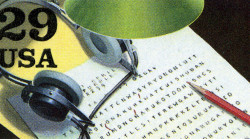Tracie Spinale
Learning Programs Manager
Smithsonian Institution
Middle School (13 to 15 years old), High School (16 to 18 years old), Post-Secondary
Teacher/Educator, Curriculum Coordinator, Parent, Museum Staff
Language Arts And English, Science, Social Studies, Arts, Special Education, Career and Tech Ed, Other
: Museum Studies
Hi there! I am Learning Programs Manager at the Office of the Under Secretary for Education (OUSE) where I focus on positive youth develop programs
Enjoy!
- Positive Youth Development
- 4-H & 4-H Guide to the Smithsonian booklet
- Boys & Girls Clubs of America
- All Access Digital Arts Program - Collections for teens and youth with cognitive differences
- Distance Learning Resources
- A cultural science series from the Smithsonian Arctic Studies Center in Alaska (#arcticstudies)
- Maker and activity collections about environmental and social justice issues
- Topical collections
- A series on the intersection of Buddhism and Western Science
Tracie Spinale's collections
Smithsonian Career Connections
<p>Check out the wide variety of careers available at the Smithsonian and Smithsonian-adjacent fields. From Art to Zoology and everything in-between--if you have a passion and interest--there's a STEAM career for you!</p>
 Tracie Spinale
Tracie Spinale
88
Boys & Girls Clubs of America (BGCA) Guide to the Smithsonian // Activities
<p>The content in this Guide, along with the accompanying online resources and activities in the Smithsonian Learning Lab, features people, places, and things of the Smithsonian Institution around the Boys & Girls Clubs of America (BGCA) themes of: </p>
<ul><li>DEMOCRACY & CIVICS </li><li> DIVERSITY, EQUITY, ACCESS & INCLUSION</li><li> STEM, HEALTHY LIVING & ENVIRONMENT</li><li>SOCIAL IDENTITY</li><li>CAREERS</li></ul>
<p>With over 157.2 million objects and specimens in our collections, we’ve selected <em>some</em> of the most relevant and interesting content the Smithsonian has to offer for BGCA youth and teens based on these topics on or near the National Mall in Washington, D.C. during the Summit for America's Youth. <br></p>
<hr>
<p>BONUS: <a href="https://learninglab.si.edu/q/ll-c/xBNvZo0yH1st2hrY" target="_blank">Smithsonian Career Connections</a></p>
 Tracie Spinale
Tracie Spinale
138
Smithsonian Career Connection
<p>Check out the wide variety of careers available at the Smithsonian and Smithsonian-adjacent fields. From Art to Zoology and everything in-between--if you have a passion and interest--there's a STEAM career for you!</p>
 Tracie Spinale
Tracie Spinale
88
Species Conservation & Challenging Perceptions of Zoos
<p>Use the worksheet, videos, images, and informational texts for the activity "Challenging Perceptions of Zoos," to discuss how zoological and conservation parks carry out their mission to save species. Through the lens of the Western Lowland gorilla, Cuban crocodile, Sloth bear, California sea lion, and the Asian elephant--consider how these animals--endangered in their natural habitats through climate change, human conflicts, or hunting--are being conserved, or saved from extinction through the work of scientists and staff in zoos and conservation parks. <br></p>
<hr>
<p>KEYWORDS: student engagement, teen council, conservation biology, Earth Optimism, #earthoptimism, animals, zoos, zoo, zoological</p>
 Tracie Spinale
Tracie Spinale
55
Murals
<p>Examples: videos about murals at the Smithsonian; murals about pieces in the Smithsonian collections; murals about social issues; murals through time; artists working on murals; design process of murals; celebratory murals about various kinds of labor and industries; protest murals; murals depicting an idealized version of history; example of student project/artist statements</p>
 Tracie Spinale
Tracie Spinale
113
SENSES SERIES
<p>Aggregate of Learning Lab collections about the Smithsonian collaboration with the Science for Monks and Nuns Program - senses and sensory perception.<br /></p>
 Tracie Spinale
Tracie Spinale
11
Lesson Plans - All Access Digital Arts Club: Activities + Plans for Neurodiverse Teens
<p>The Smithsonian Office of Educational Technology's All Access Digital Arts Program (2012-2016) provided skill-building opportunities in digital arts and communications, creative expression, and social inclusion to a spectrum of teen learners in the Washington, DC metro area. Participating youth visited Smithsonian science, history, and art museums, created digital and physical artworks based upon a tailored curriculum, engaged in social interactions online and in-person, gained digital literacy skills, and developed friendships with other teens.
Through once-per-month club outreach activities and summer intensive camps and workshops, students were exposed to communication, collaborative learning, research, and problem solving. The program served up to 20 youth per session, ages 14 through 22 with cognitive and intellectual disabilities. The youth experienced skill building, leadership opportunities, and social integration through Smithsonian resources, socialization opportunities, and computer skills. Youth participated in 1.) One- and two-week multi-media digital arts workshops whose outcome was student-produced artworks, songs, and movies that were shared with family and friends at openings and online via a social network; and 2.) Club activities--to build upon skills developed during the summer, and maintain social connections. </p>
<p>All Access Club activities were offered to alumni of the summer workshops, and were held once monthly on Saturdays during the year to build upon skills developed during the workshop, and maintain social connections. During the club, teens practiced social skills through guided activities and Smithsonian museum visits, and produced original digital and hands-on art projects at the Hirshhorn ARTLAB+. Educators led the group in a series of planned educational activities related to the day’s theme—such as “the universe” or “oceans”. Volunteers assisted club members to use social media, tablets, cameras and laptops to facilitate the digital experience. The activities and resources promoted digital literacy skills, and can motivate families to visit museums to learn, and for teens to build self-esteem. An evaluation session on the final day allowed teens to express their thoughts to the club organizers.</p>
<p>Special thanks to colleague Joshua P. Taylor, M.Ed., VCU Autism Center for Excellence, Virginia Commonwealth University</p>
<p>Keywords: access, disability, accessibility, neurodiversity, special education, SPED, out of school learning, informal learning, cognitive, social skills, engagement, passion, creativity, empowerment, self-determination, teens in museums, teens, teenagers, after school, out of school learning, informal learning<br></p>
 Tracie Spinale
Tracie Spinale
19
Shelley's "Ozymandias" Poem: Museum Objects and Inspired Art
<p>How have museum objects and antiquities inspired arts and literature? Read and listen to a famous poem written two hundred years ago by English author Percy Bysshe Shelley, "Ozymandias." Then, view artworks which in turn were inspired by the poem. View the environmental landscapes and settings in ancient Egypt which inspired the original poem about the colossal sculpture of a famous ruler from over three thousand years ago. The collection concludes with a link to view a draft of the poem. Will Shelley's work inspire the creation of your own poem or artwork about a place you've traveled, or an object you've seen in a museum?</p>
<p>For a hand's-on paper-craft activity for younger students, visit <a href="https://learninglab.si.edu/q/ll-c/8MmERhz4keCesAxN"><strong>Nile, Nile Crocodile</strong></a> collection</p>
<p>keywords: sonnet, Ancient Egypt, Rameses II, Thebes, impermanence, cultural patrimony, distance learning, poetry, object-based learning</p>
 Tracie Spinale
Tracie Spinale
23
Ciphers and Codes
<p>Throughout history, ciphers and secret codes were devised to keep intelligence from falling into the wrong hands. From the WWII German "Enigma" machine, to America's Cherokee Code Talkers, people used ciphers and codes to safeguard secrets. One of my favorite mysterious artworks is the sculpture <em>Antipodes,</em> outside of the Hirshhorn Museum. No one knows what it means, and its companion piece <em>Kryptos</em> is at Langley. Use this collection an inspiration piece for puzzle lovers and mystery solvers both young and old. There are many free sites on the web that you can use to create your own coded messages like, "Jsotd ymj Qjfwsnsl Qfg!" (Hint: Caesarian Shift).</p>
 Tracie Spinale
Tracie Spinale
25
Access Series: Fantastic Creatures
<p>This topical collection of artworks is based upon "fantastical creatures." It was originally used in a collage art activity (printed out; using paper, glue, and art materials); and as a discussion prompt in an informal learning activity with a group of teens with cognitive disabilities during a summer camp program. <br></p>
<p>Other suggested uses beyond collage and discussion prompts would be a writing exercise, utilizing the "See|Think|Wonder" visible thinking routine or the “Conversing with an Object” discussion prompt as writing inspiration. You could also pair the collection with popular young adult fantasy novels, and ancient myths and legends. Or draw your own fantastic creature.<br><br> Descriptors: Decision Making, Disabilities, Self-Determination, Self-Efficacy, Student Empowerment, All Access Digital Arts Program, teens in museums, teens, teenagers, after school, out of school learning, informal learning</p>
 Tracie Spinale
Tracie Spinale
41
Access Series: Nostalgic Popular "Pop" Culture
<p>This inspiration collection of nostalgic popular "pop" culture from the 1950s, 1960s, 1970s, 1980s, 1990s and 2000s—super heroes and super villains, Muppets, cartoon characters, Star Wars, Disney and Pixar characters, Transformers, and movies was used for a collage activity and discussion prompt in an informal learning activity, "Me & My World: Personal Ecology/Interest Inventory" with a group of teens with cognitive and intellectual disabilities. Students were asked about their favorite pop culture influences from the past and present. <br></p>
<p>Use one of the activity prompts to spark discussion.</p>
<p>Tags: decision-making, self-determination, student empowerment, disability, All Access Digital Arts Program, teens in museums, teens, teenagers, after school, out of school learning, informal learning</p>
 Tracie Spinale
Tracie Spinale
83
Access Series: Flying Things
<p>This topical collection of airplanes, hot air balloons, space craft, and other things that fly, was originally used in a collage art activity (printed out; using paper, glue, and art materials). It was used as a discussion prompt in an informal learning activity with a group of teens with cognitive disabilities during a summer camp program--as pre-museum visit preparation to artifacts that would be found at an airplane museum. </p>
<p>Other suggested uses beyond collage and discussion prompts would be a writing exercise, "If you could fly anywhere, where would you go and what would you do?" Use the visible thinking routine, "See|Think|Wonder" as a starting point for the writing prompt, and the images for inspiration. There is a suggested lesson plan included which can be adapted to a visit to an air and space museum.</p>
<p>Tags: decision-making, self-determination, student empowerment, disability, all access digital arts program, teens in museums, teens, teenagers, after school, out of school learning, informal learning</p>
 Tracie Spinale
Tracie Spinale
94





















